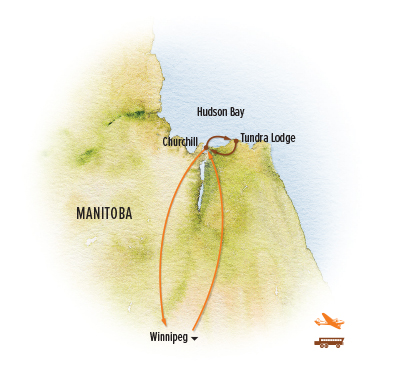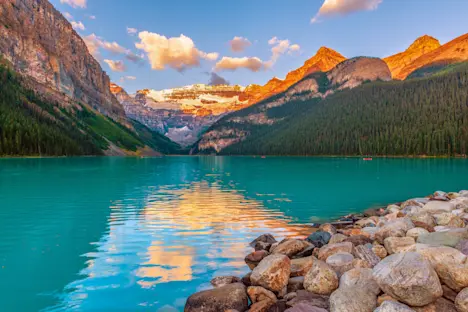Itinerary

Arrive in Winnipeg and transfer to the historic Fort Garry Hotel. Built in 1913 by the Canadian Pacific Railway, this prestigious landmark has long been a symbol of genteel elegance in the heart of Manitoba's capital, which was once a fur-trading post and railway boomtown and today is the cultural and commercial center of Canada's eastern prairie region. Once you arrive, visit our gear room in the hotel to pick up your heavy Arctic parka and winter boots to use while you are in Churchill. This evening, gather for a welcome dinner with our Expedition Leader.
Fly on our private chartered aircraft to Churchill this morning, where we board a custom-designed Polar Rover vehicle for our transfer to the Tundra Lodge. As we drive out of town, watch for Arctic wildlife against the vast, wide-open landscape—we may even get our first polar bear photos en route. Once we reach our hospitable outpost on the tundra, get settled in to spend the next two nights surrounded by the vast expanse of treeless plain on the edge of Hudson Bay. Then it’s time to gather for a presentation on polar bears by one of our naturalist Expedition Leaders. Our guides are experts on the natural history of the Canadian Arctic, and you’re sure to learn a lot during this enlightening introduction to our northern adventure. Later, as dinner is served in the Tundra Lodge dining room, keep your camera at the ready—we often see polar bears wandering right outside the windows!
Accommodating just 29 guests, the Tundra Lodge is strategically positioned near the edge of Hudson Bay in the best area for polar bear viewing. Inquisitive bears often approach the lodge, which features rows of windows and safely elevated outdoor observation decks to accommodate our own curiosity. As we watch the bears interact, we're delighted by their antics and rugged beauty. We may see protective mothers with cubs, young males play-fighting, and solitary individuals patrolling the tundra as they wait for the ice to form on Hudson Bay, signaling the start of their winter seal-hunting season.
The unique location of the Tundra Lodge, combined with excursions in our all-terrain Polar Rover vehicles, offers lodge guests the best possible wildlife encounters in the region. The small spit of land where the lodge is situated near the bay often attracts the greatest number of bears in the area. We typically divide up for activities so each traveler enjoys a half-day excursion on the tundra, complemented by a half-day of viewing bears from the lodge. In addition to polar bears, we may also spot caribou, Arctic fox, Arctic hare, snowy owl and ptarmigan. At the end of an exhilarating day, gather inside our cozy accommodation for dinner and a naturalist presentation. And if we are fortunate to have a rare clear autumn night, we might even see the northern lights after dark.
Depart the Tundra Lodge after breakfast and head back out to the tundra for a final full day immersed of nature and wildlife observation. Traveling aboard our Polar Rover, scout for polar bears and other Arctic species. Our vehicles are the newest and best in Churchill, with huge windows, a slanted front windshield that allows us to look down on bears that may wander in front of the vehicle, and a steel-grate outdoor observation deck on the back—bears sometimes wander directly below, and through the mesh we can safely view them just inches away! Our heated vehicles are spacious and comfortable, and while they can accommodate 30-plus passengers, we hold our numbers to 16 or fewer, so everyone has a window seat and plenty of room to spread out for photography. Later this afternoon, we drive back to Churchill and check in to our hotel. We’ll have dinner at a restaurant in town, followed by an evening cultural presentation.
This remote subarctic hamlet of Churchill, with a population of fewer than 900, is accessible only by air or rail. We have a full day to explore its Indigenous heritage, frontier history and contemporary life on a comprehensive tour of this northern outpost and surroundings. Located on the southwest coast of Hudson Bay, Churchill is the hub of a region that has been frequented by humans for at least 4,000 years. Archaeological evidence supports the presence of semi-nomadic Pre-Dorset and Dorset cultures using the area as a seasonal hunting ground, sustained by caribou in summer and ringed seals in winter. The Thule culture, which arrived around 1000 AD, are the ancestors of today’s Inuit. Long before Europeans arrived, the Cree, Dene and Inuit had well-established trading networks in the area. Their descendants live on in modern-day Churchill, and we have special opportunities to meet and hear from elders who sustain vital traditions.
Henry Hudson was the first European to explore the bay that bears his name, arriving by ship in 1610 in search of the Northwest Passage. Later, in 1670, the Hudson's Bay Company was established, the oldest commercial corporation in the world. It established a fur trading post at the mouth of the Churchill River, which grew in importance when Fort Churchill was built on the site in 1717 , with Fort Prince of Wales following in 1731. In the 1920s, the latter became part of Parks Canada, recognizing its important status in the development of the region and putting resources toward its reconstruction in the 1930s, when the opening of the railroad allowed access to materials and heavy equipment to rebuild it. Today, the fort is a National Historic Site, which we pass during tour.
Our adventure continues outside town as we drive the rugged roads over the tundra, scanning the windswept plain and boreal forest edge for Arctic wildlife. With luck, we may spot polar bears ambling along the rocky coastline or resting on the tidal flats, patiently waiting for the sea ice to form and hunting season to begin. We also have good chances to see Arctic fox, Arctic hare, and a variety of birds, including snowy white ptarmigan. Back in town, take time to wander the few blocks that make up Churchill's compact core. Browse local shops selling handmade northern crafts, Indigenous artwork and distinctive souvenirs that embody the spirit and resilience of life on the edge of the Arctic. We then gather for dinner on our final night in Churchill.
This morning we learn about and experience a distinctly northern pastime: dog sledding. On a visit with a local Metis musher who has been a significant force in furthering the Indigenous heritage of using sled dogs in the Arctic, hear all about this traditional means of northern transportation, interacting with the lively dog team as we learn about their care and training. Then we take turns enjoying an exhilarating ride as the dogs whisk us down a trail through the boreal forest.
Depending on flight schedules, there may be time for an optional helicopter tour over the tundra—a great chance to spy polar bears from the air. We enjoy a final lunch together in Churchill before our return chartered flight to Winnipeg, followed by a farewell dinner and final night at the Fort Garry Hotel.
After breakfast, transfer to the airport for flights home.
Please note: Itineraries may vary slightly and activities may happen at times different from what is listed, but inclusions are the same.
An important note on polar bear viewing: Since 1989, we have run approximately 1,500 departures to Churchill to view polar bears, and we’ve missed seeing them on just a handful of occasions. Some of our sightings are up close, and others are from afar, or even from a helicopter. It’s important to remember that while there is no better opportunity to see polar bears in the wild than our Churchill trips offer, the experience is weather-dependent. That means viewing polar bears—and the distance at which we may see them—is unpredictable and not guaranteed.
Check out more details on the ebbs and flows of the Churchill polar bear viewing season.































